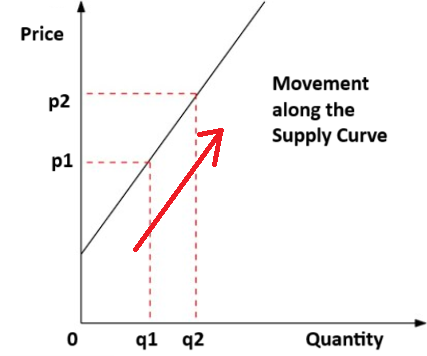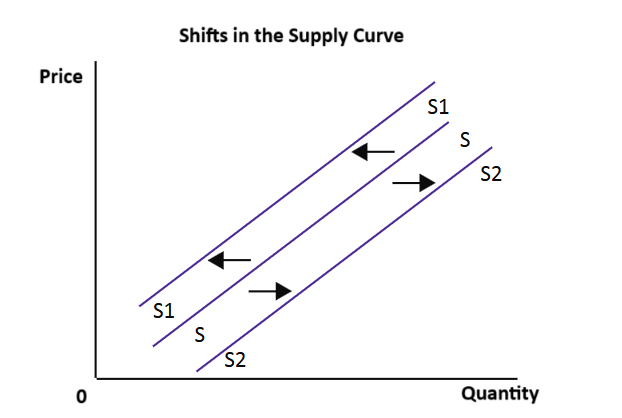Supply
This section explains supply as part of A-Level Economics, covering movements along the supply curve and shifts of the supply curve.
The Distinction Between Movements Along a Supply Curve and Shifts of a Supply Curve
Movements Along a Supply Curve
Definition: A movement along the supply curve occurs when there is a change in the price of a good or service, which leads to a change in the quantity supplied.

Reason for Movement: Movements along the supply curve happen only when the price of the good changes, causing suppliers to adjust the quantity they are willing and able to supply.
- Example: If the price of wheat rises, producers will supply more wheat (assuming the price increase makes it more profitable to do so). This causes a movement upward along the supply curve.
- Key Point: Movements along the supply curve are caused only by price changes, resulting in an increase or decrease in the quantity supplied.
Shifts of a Supply Curve
Definition: A shift in the supply curve occurs when there is a change in a factor other than the price of the good or service, leading to a change in the quantity supplied at every price level.

Reason for Shift: Shifts of the supply curve are caused by changes in factors such as production costs, technology, or government policies.
- Example: If new technology makes the production of cars cheaper, the supply of cars will increase, causing the entire supply curve to shift to the right (an increase in supply).
- Key Point: Shifts in the supply curve are caused by changes in non-price factors, such as technology, costs of production, and government interventions.
The Factors That May Cause a Shift in the Supply Curve (The Conditions of Supply)
The supply curve can shift due to various factors, collectively referred to as the conditions of supply. These factors influence the willingness and ability of producers to supply a good or service.
Key Factors Causing a Shift in the Supply Curve:
Cost of Production:
- If the cost of raw materials, wages, or energy increases, the cost of production will rise, leading to a decrease in supply. This causes the supply curve to shift to the left (a decrease in supply).
- Conversely, if production costs decrease (e.g., due to cheaper raw materials or lower wages), the supply will increase, shifting the supply curve to the right (an increase in supply).
- Example: If the price of steel increases, the cost of manufacturing cars rises, and the supply of cars decreases, shifting the supply curve to the left.
Technology:
- Technological advancements can make production more efficient, reducing costs and increasing supply. This causes the supply curve to shift to the right.
- Example: The introduction of automated machinery in factories may lower the cost of producing goods like electronics, increasing the supply and shifting the supply curve to the right.
Government Policies:
- Government policies such as taxes, subsidies, and regulations can influence supply. If taxes on production increase, the supply curve will shift to the left (decreasing supply). If subsidies are provided to producers, the supply curve will shift to the right (increasing supply).
- Example: A subsidy on solar panel production encourages firms to supply more solar panels, shifting the supply curve to the right.
Number of Sellers:
- An increase in the number of producers in a market will increase the overall supply, shifting the supply curve to the right. If some producers exit the market, the supply will decrease, shifting the supply curve to the left.
- Example: If new firms enter the mobile phone market, the supply of mobile phones will increase, shifting the supply curve to the right.
Expectations of Future Prices:
- If producers expect the price of a good to rise in the future, they may reduce their current supply to sell more later at higher prices, causing the supply curve to shift to the left in the short term. If they expect prices to fall in the future, they may increase current supply, shifting the supply curve to the right.
- Example: If producers expect the price of oil to rise in the future, they may reduce current oil production, shifting the supply curve to the left.
Weather and Natural Conditions:
- In some industries, particularly agriculture, the weather and natural conditions can significantly affect supply. Poor weather conditions, such as droughts or floods, may reduce supply, shifting the supply curve to the left. Conversely, favourable weather can increase supply, shifting the curve to the right.
- Example: A poor harvest due to bad weather can reduce the supply of crops, shifting the supply curve to the left.
Summary of Key Points
| Factor | Effect on Supply Curve | Example |
|---|---|---|
| Cost of Production | Increase in costs = shift left (decrease in supply), Decrease in costs = shift right (increase in supply) | Rising wages for factory workers increasing production costs leads to reduced supply. |
| Technology | Technological improvements = shift right (increase in supply) | The introduction of automation reduces the cost of production, leading to more supply. |
| Government Policies | Increase in taxes = shift left (decrease in supply), Subsidies = shift right (increase in supply) | A new tax on carbon emissions may decrease the supply of fossil fuels. |
| Number of Sellers | Increase in number of sellers = shift right (increase in supply), Decrease in sellers = shift left (decrease in supply) | More firms entering the mobile phone market increases the overall supply of mobile phones. |
| Expectations of Future Prices | Expectation of higher future prices = shift left (decrease in supply), Expectation of lower prices = shift right (increase in supply) | Expecting a price rise in oil may lead firms to decrease current production. |
| Weather and Natural Conditions | Bad weather = shift left (decrease in supply), Good weather = shift right (increase in supply) | A poor harvest due to drought reduces the supply of agricultural products. |
Summary
Understanding supply is crucial for analysing how producers respond to changes in market conditions. Movements along the supply curve reflect changes in price, while shifts in the supply curve are influenced by a variety of non-price factors such as production costs, technology, government policies, and external factors like weather. By recognising these factors, economists can better predict how supply will change in response to different circumstances, which in turn helps businesses and governments make informed decisions.
